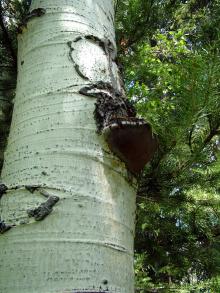Cause The fungus Phellinus tremulae incites a common heartrot of aspen, which can be found in just about every PNW grove. It is critically important for wildlife tree-cavity formation. Studies in drier forests of the PNW indicate that aspen groves are hotspots for wildlife habitat, with a major "cavity nest web" that develops, started by primary excavating woodpeckers, and then including swallows, nuthatches, bats, and other mammals, etc. The presence of a single fruiting body (conk) indicates considerable decay up to as much as 82% of the tree volume. Spores are released throughout the growing season and infect dead branches, branch stubs or wounds. New fruiting bodies may not be formed for several years after initial infection.
Symptoms There are often no external indicators of this decay until a fruiting body is formed. The fruiting bodies form at branch scars and are perennial, hard and woody with a triangular shape in longitudinal section. The upper and lower surface of the conk is roughly at a 45° angle. The upper surface is zoned gray to black while the bottom is brown. Decayed wood in fresh cut trees is yellowish, white and spongy with a distinct wintergreen odor.
Cultural control Protecting aspen from stem wounds and fire damage and maintaining dense stands may reduce incidence of decay.
Reference Allen, E., Morrison, D., and Wallis, G. 1996. Common Tree Diseases of British Columbia. Natural Resources Canada. Canadian Forest Service. pp178.

